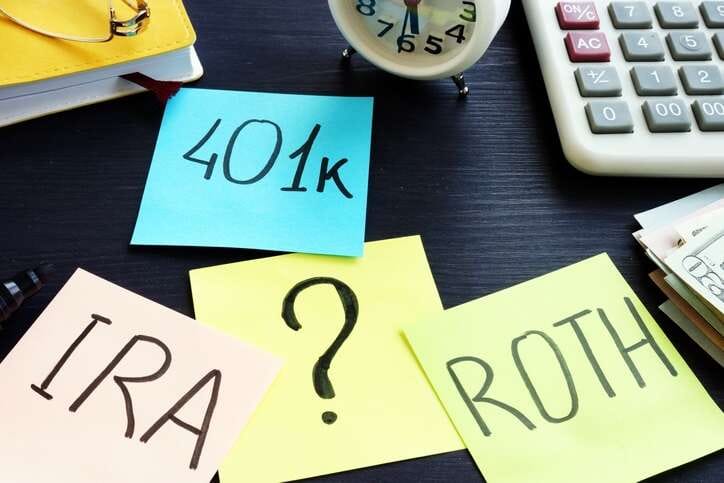
About 13 types of retirement accounts are available in the U.S., both individual and employment-sponsored. Each account option has different restrictions, benefits, and features.
Traditional IRA vs. Roth IRA
IRA stands for “individual retirement account.” Thus, you can open an IRA on your own without going through an employer.
A traditional IRA:
- Lets you make pre-tax contributions
- Allows for tax-deferred growth
- Requires you to pay taxes when withdrawing funds
A Roth IRA:
- Lets you make after-tax contributions
- Allows for tax-free growth
- Offers qualified tax-free withdrawals
You can have both a traditional and a Roth IRA. This tax diversification strategy can help you prepare for an uncertain tax future at the time of retirement.
401(k)
A 401(k) is an employer-sponsored plan that allows you to make retirement contributions. Some employers will match a certain amount or percentage of your contributions.
401(k) accounts can be structured as either traditional or Roth accounts.
Solo 401(k)
One variation of the 401(k) is the solo 401(k), also called a one-participant 401(k). These plans are for self-employed individuals who have no employees other than themselves or their spouses.
403(b)
A 403(b) account is similar to a 401(k), but it is administered by a tax-exempt organization like a nonprofit or school. These accounts allow you to make pre-tax contributions, and employers can choose to match your contributions.
457(b)
A 457(b) account is a deferred compensation plan, which means that it’s an addition to your salary that isn’t taxed as income or paid out until a future date (usually retirement). This type of plan is usually seen in the nonprofit and government sectors.
Simplified Employee Pension (SEP)
SEPs are traditional IRAs for those who are self-employed or who own small businesses. You can make tax-deductible contributions to these accounts.
Savings Incentive Match Plan for Employees (SIMPLE)
A SIMPLE IRA is a small business retirement plan designed for companies with 100 or fewer employees. Both the employee and the employer can make pre-tax contributions to SIMPLE IRA accounts.
Profit-Sharing Plan
Profit-sharing plans allow employers to contribute a portion of the company’s profits to their employees’ retirement accounts. These contributions are typically made pre-tax.
Employee Stock Ownership Plan (ESOP)
With an ESOP, employees can acquire partial ownership in a company through contributions to their retirement accounts in the form of company stock.
Defined Benefit Pension Plan
A defined benefit pension plan is a traditional pension where an employer guarantees a predetermined monthly benefit upon retirement. This type of plan is dependent on specific factors, such as the years of service an employee gives to a company.
Cash Balance Pension Plan
A cash balance pension plan is a type of defined benefit plan that allows employers to make contributions of a fixed percentage of their employees’ salaries. The contribution account also grows at a fixed interest rate.
Annuities
Annuities are financial offerings by insurance companies that offer an income stream during retirement in exchange for periodic contributions.
Which Retirement Account Is Right for Me?
The right retirement account for you will depend on factors like your tax situation, financial goals, employment status, and income level.
When determining which retirement account or accounts are right for you, you should start by determining your eligibility.
According to Ty Young, CEO of Ty J. Young Wealth Management, which specializes in retirement strategy, it is best to determine which retirement strategy suits your specific timeline and lifestyle before choosing which accounts to fund.
First, find out whether your employer offers any retirement plans. If you are self-employed, determine which individual plans you are eligible for.
You should evaluate any employer-sponsored plans if they’re available to you. If your employer offers a 401(k) or a similar plan, you should consider participating, especially if your employer offers matching contributions. It’s nearly always a good idea to contribute to a 401(k) or 403(b) up to your employer’s match limit.
For example, suppose that your employer matches 50% of your contributions up to 6% of your salary. You should contribute at least 6% to get the full match. After that, you can decide whether contributing more to your 401(k) or opening an IRA is the best option.
Ty Young often advocates not leaving potential employer match opportunities on the table because of the future returns you are missing out on. He also talks about the importance of rolling those accounts over each time you move to a new job.
You should also consider the tax implications of retirement accounts. Depending on your situation, a pre-tax or after-tax account may better suit your needs. Or you may want to have both types of accounts in your portfolio for greater diversity.
Finding the Right Retirement Account
Think about your retirement needs. How much income will you need when you retire? What is your timeline for retirement? What is your risk appetite? Knowing the answers to these questions will help you figure out which retirement account will best suit your needs.
Finding the right retirement account isn’t simple or easy — not when there are so many options, eligibility requirements, things to consider, and things to know.
Perhaps the best way to determine what retirement account is right for you is by consulting with a financial professional who will help you understand your options and decide which is best suited for your unique situation.


